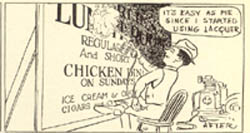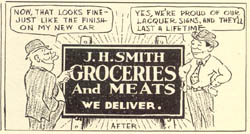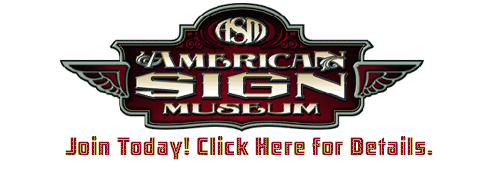|
|
Why Lacquer Is Coming To The Front
by E.C. Matthews
from Signs of the Times magazine; July, 1930 issue, pp. 27, 99

Today there are any number of good gum lacquers on the market, intended especially for sign work. When dry these are less brittle than the auto finishing lacquers, and hence far better for sign purposes. The greatest improvement of all, in my estimation, is the good, durable clear lacquer made by the Atlantic Chemical Company.
Lacquer signs are apt to grow dull, after a few months, unless they are polished. A coat of good durable clear lacquer eliminates this trouble. All of the other clear lacquers I have tried were less durable than the colored lacquer. Now many shops are giving their signs a coat of clear lacquer. This is not necessary on trucks as the regular washing and polish of the machine keeps the signs bright and lustrous.

Last fall I was in Los Angeles and visited Al Vaughn, the inventor of Lackermask, at the Voquett & Vaughn Studios. There I saw lacquer signs of all sizes up to forty feet long, being made in the most approved way.
A helper coats the background with a spray gun, then the sign painter letters on the small stuff and outlines the large lettering, leaving the helper to fill in with "mud" (Lackermask) on the large work. Dozens of coated signs were piled on the racks. When the final coat is dry the sign is thrown on the wash rack and may be washed under pressure at any time, from a few hours to a week after the work is done.
Most of the signs are made on Galvannealed metal, although wallboard is sometimes used. The metal is framed first, and the molding, which has been painted with oil color, is tacked in the corners or on the face after the lacquer sign is completed. The quality and finish of the work is far superior to anything produced with paint and all the irksome labor of cutting-in is avoided. In a short article, it is impossible for me to go into full details about the lacquer system; but there are a few advantages and stunts of real importance that I would like to mention. One is regarding the method of applying lacquer.
The proper way to apply the material is to first fog on a very light coat and let it dry a few minutes before applying the regular coat of lacquer. This should be done with the primer, white coat, all colors, and the clear lacquer finish.
The fog coat makes the primer stick better; the white fog coat keeps the primer from bleeding into the white; a fog coat of the background color over the lackermask keeps the color from blowing through the masking paste; and finally, a fog coat of clear lacquer, blown on lightly before the full finishing coat, will prevent the colors from running together or "bleeding" into the clear lacquer.
Learning to blow on this light fog coat, with the gun held some distance from the work, will eliminate most lacquer trouble. It causes the mask to wash off easier and prevents all trouble from bleeding colors.
Another problem simply solved is the removal of the masking paste without water pressure. Of course, high pressure is preferable, but you can wash the signs with an ordinary hose and a stiff bristle brush.
A stiff one-inch brush with a strip of tin bound tightly around the bristles, leaving about a quarter of an inch of the stock exposed and used like a putty knife or scraper, will remove all the mask from the finished sign without any trouble or injury to the lacquer.
A power auto washer with a two-horse electric motor will develop three hundred pounds of water pressure, and is ideal for washing lacquer signs. Such a machine costs a little over $200. For the gun you will require an outfit that will maintain a pressure of sixty pounds or more while in use. I have seen several equipped with a quarter horse power motor that worked very well. The larger outfits are better. The little cheap outfits are not adaptable to lacquer spraying.
I have used quarter horse power outfits quite successfully, and I would recommend an outfit selling at about $100 complete in preference to anything cheaper. Most of the larger size outfits are good, but the smaller portables usually will not maintain sufficient pressure to carry gun lacquer.
A good airbrush stunt, which was explained by Al Vaughn, is to thing fat oil size about half and half with gasoline and then use the lacquer gun to spray this on wood letters that are to be gilded. This gives a perfectly even coat of size all over the letters and insures a beautiful burnish.
From the sign painter's viewpoint the greatest advantages of lacquer are the speed with which it can be handled, the elimination of all cutting in, and the fact that all brush work is done with one medium; no washing of brushes and changing from one color to another. From the customer's viewpoint the greatest advantages are the beauty equal to baked enamel in both respects--in fact less brittle than the enamel--and small signs can be delivered the same day they are ordered, if necessary.
Home | News | Exhibits | Events | Links | Talk | FAQ | Contact Us
